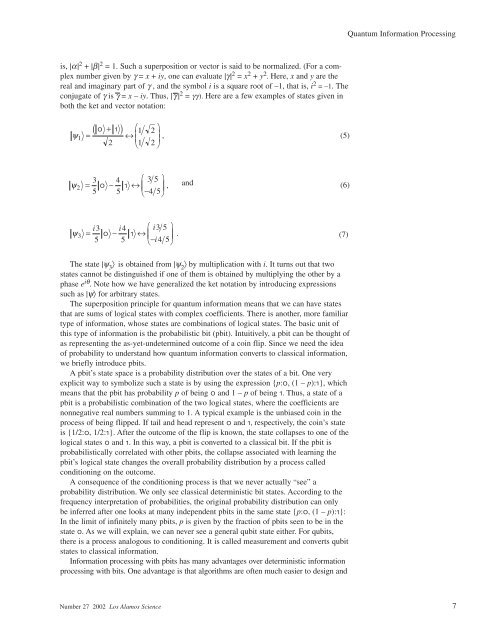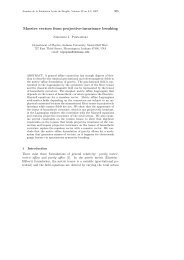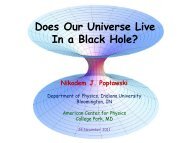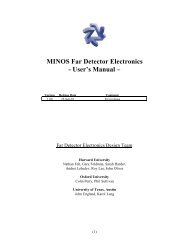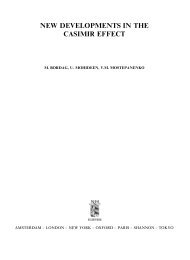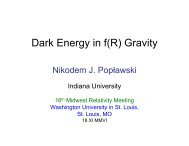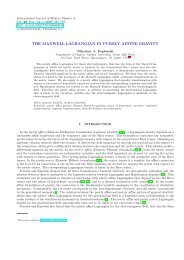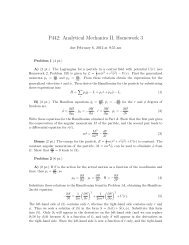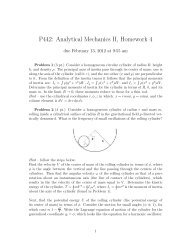Quantum Information Processing
Quantum Information Processing
Quantum Information Processing
You also want an ePaper? Increase the reach of your titles
YUMPU automatically turns print PDFs into web optimized ePapers that Google loves.
is, |α| 2 + |β| 2 =1. Such a superposition or vector is said to be normalized. (For a complex<br />
number given by γ = x + iy, one can evaluate |γ| 2 = x 2 + y 2 . Here, x and y are the<br />
real and imaginary part of γ , and the symbol i is a square root of –1, that is, i 2 = –1. The<br />
conjugate of γ is γ = x – iy. Thus, |γ | 2 = γγ). Here are a few examples of states given in<br />
both the ket and vector notation:<br />
ψ 1<br />
ψ 2<br />
ψ 3<br />
( + ) ⎛1<br />
2⎞<br />
= ↔ ⎜ ⎟<br />
2<br />
⎜<br />
⎝1<br />
2<br />
⎟<br />
,<br />
⎠<br />
3 4 ⎛ 35⎞<br />
= − ↔<br />
5 5<br />
⎜<br />
⎝−45<br />
⎟ ,<br />
⎠<br />
i3i4⎛i35⎞ = − ↔<br />
5 5<br />
⎜<br />
⎝−i45<br />
⎟ .<br />
⎠<br />
and<br />
The state |ψ 3 〉 is obtained from |ψ 2 〉 by multiplication with i. It turns out that two<br />
states cannot be distinguished if one of them is obtained by multiplying the other by a<br />
phase e iθ . Note how we have generalized the ket notation by introducing expressions<br />
such as |ψ〉 for arbitrary states.<br />
The superposition principle for quantum information means that we can have states<br />
that are sums of logical states with complex coefficients. There is another, more familiar<br />
type of information, whose states are combinations of logical states. The basic unit of<br />
this type of information is the probabilistic bit (pbit). Intuitively, a pbit can be thought of<br />
as representing the as-yet-undetermined outcome of a coin flip. Since we need the idea<br />
of probability to understand how quantum information converts to classical information,<br />
we briefly introduce pbits.<br />
A pbit’s state space is a probability distribution over the states of a bit. One very<br />
explicit way to symbolize such a state is by using the expression {p:, (1 – p):}, which<br />
means that the pbit has probability p of being and 1 – p of being . Thus, a state of a<br />
pbit is a probabilistic combination of the two logical states, where the coefficients are<br />
nonnegative real numbers summing to 1. A typical example is the unbiased coin in the<br />
process of being flipped. If tail and head represent and , respectively, the coin’s state<br />
is {1/2:, 1/2:}. After the outcome of the flip is known, the state collapses to one of the<br />
logical states and . In this way, a pbit is converted to a classical bit. If the pbit is<br />
probabilistically correlated with other pbits, the collapse associated with learning the<br />
pbit’s logical state changes the overall probability distribution by a process called<br />
conditioning on the outcome.<br />
A consequence of the conditioning process is that we never actually “see” a<br />
probability distribution. We only see classical deterministic bit states. According to the<br />
frequency interpretation of probabilities, the original probability distribution can only<br />
be inferred after one looks at many independent pbits in the same state {p:, (1 – p):}:<br />
In the limit of infinitely many pbits, p is given by the fraction of pbits seen to be in the<br />
state o. As we will explain, we can never see a general qubit state either. For qubits,<br />
there is a process analogous to conditioning. It is called measurement and converts qubit<br />
states to classical information.<br />
<strong>Information</strong> processing with pbits has many advantages over deterministic information<br />
processing with bits. One advantage is that algorithms are often much easier to design and<br />
Number 27 2002 Los Alamos Science 7<br />
(5)<br />
(6)<br />
(7)<br />
<strong>Quantum</strong> <strong>Information</strong> <strong>Processing</strong>


